The ABCs of a Winning Product Content Strategy

Anjan Sarkar
Writer
Let’s face it: Most product descriptions are just plain awful. And that’s a shame. Because most consumers think they’re really pretty important.
Either they don’t convey the correct information or they are simply incomplete. Too many companies fail to pay attention to this small yet very important part of their business.
The few companies that do pay attention to product content, mostly focus on SEO (search engine optimization) to increase organic traffic to their product pages.
Don’t get me wrong. SEO is important, but it’s not enough.
Today, it’s important to surprise and delight your site visitors. It’s important that you build an emotional connection with them through your product copy. Not only will this encourage visitors to buy, but it will also make them come back to you again.
Let’s dig deeper into why you should focus on writing compelling product content and the key ingredients that will help you excel at it.
Your product pages need to sell, not just tell!
Did you know 81% of consumers research products on the internet before going to the store? And when they buy products online, product content is the number one factor that influences their decision.
While a great product description has the power to convince your customers to buy, a study by Nielsen Norman Group shows that 20% of customers find the information incomplete or unclear.
This has two dreadful business consequences. Firstly, an incomplete product description hinders the buying process. Not just this, even if your visitors buy the product, there’s a 30% chance that they will ask you for a return.
That’s huge!
Not only does it erode your bottom line, but it also becomes difficult to build trust among consumers if you don’t match their expectations.
While the least marketers should do is write an accurate and complete product description, they shouldn’t stop at that. There is a lot more to writing product descriptions than just features and benefits.
However, before understanding how to write convincing product copy, let’s understand how successful eCommerce companies stand out.
The two extremes of online commerce
Online purchase behaviors have largely shaped what successful eCommerce businesses look like today. There are two distinct ways in which consumers shop online – 1) using marketplaces for the necessities of daily life, and 2) going to DTC brands for the products they really care about. When the intent behind the purchase differs so much, the experiences these two types of eCommerce businesses provide should also be vastly different.
For instance, not everyone likes buying laundry detergents, extension cords, or phone chargers. But they need to. When people don’t want to put in the effort to select or purchase products, they turn to marketplaces. Marketplaces offer them convenience and efficiency. They make repetitive, mundane tasks easy.
But when athletes buy shoes or fashion enthusiasts buy clothes, the purchase matters to them. They hunt through the internet to collect all the information needed to buy those products. Moreover, when consumers care for their purchases, they want a more targeted and personalized experience that is built around a shared sense of meaning.
They want to be a part of something bigger and feel a real connection to the brands they buy from. Quick checkout and free shipping won’t cut it for them.
The story you tell them about your products will build a connection with your buyers and convince them that you understand them.
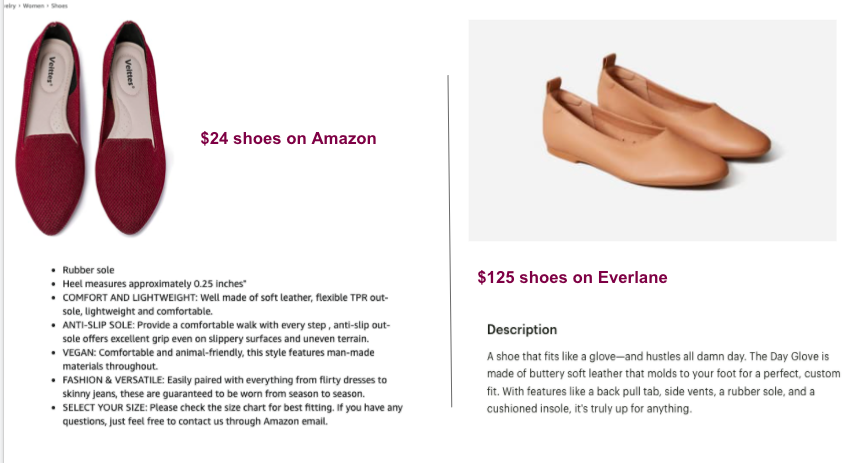
For instance, $24 shoes sold on Amazon come with a basic product description that highlights its features and benefits. That’s enough for a marketplace.
But a DTC brand like Everlane will require much more than this. It must build context, tell a story and use its customers’ language to create a product description that persuades and converts.
Consumers today expect more meaningful products from DTC brands. Consumers want companies to understand them, and curate products tailored to their needs. What you tell them about your product will define how they perceive you.
Let’s look at the key ingredients that make product content convincing.
Write epic product descriptions that sell
“Trust is the foundation of every successful sale.” (Adam Rogers, Shopify)
It is no longer enough for companies to have the best product or service. To grow and succeed, you need to build trust among your consumers, and writing a high-quality product copy is the first step towards it.
An effective product story creates context and meaning. It uses backstory and insider language to connect with the buyer. It tells them that the company understands its consumers. All of these elements are vital to the process of building trust among consumers.
With the help of this three-step framework, let’s see how you can embed these elements into your product copy and persuade your customers.
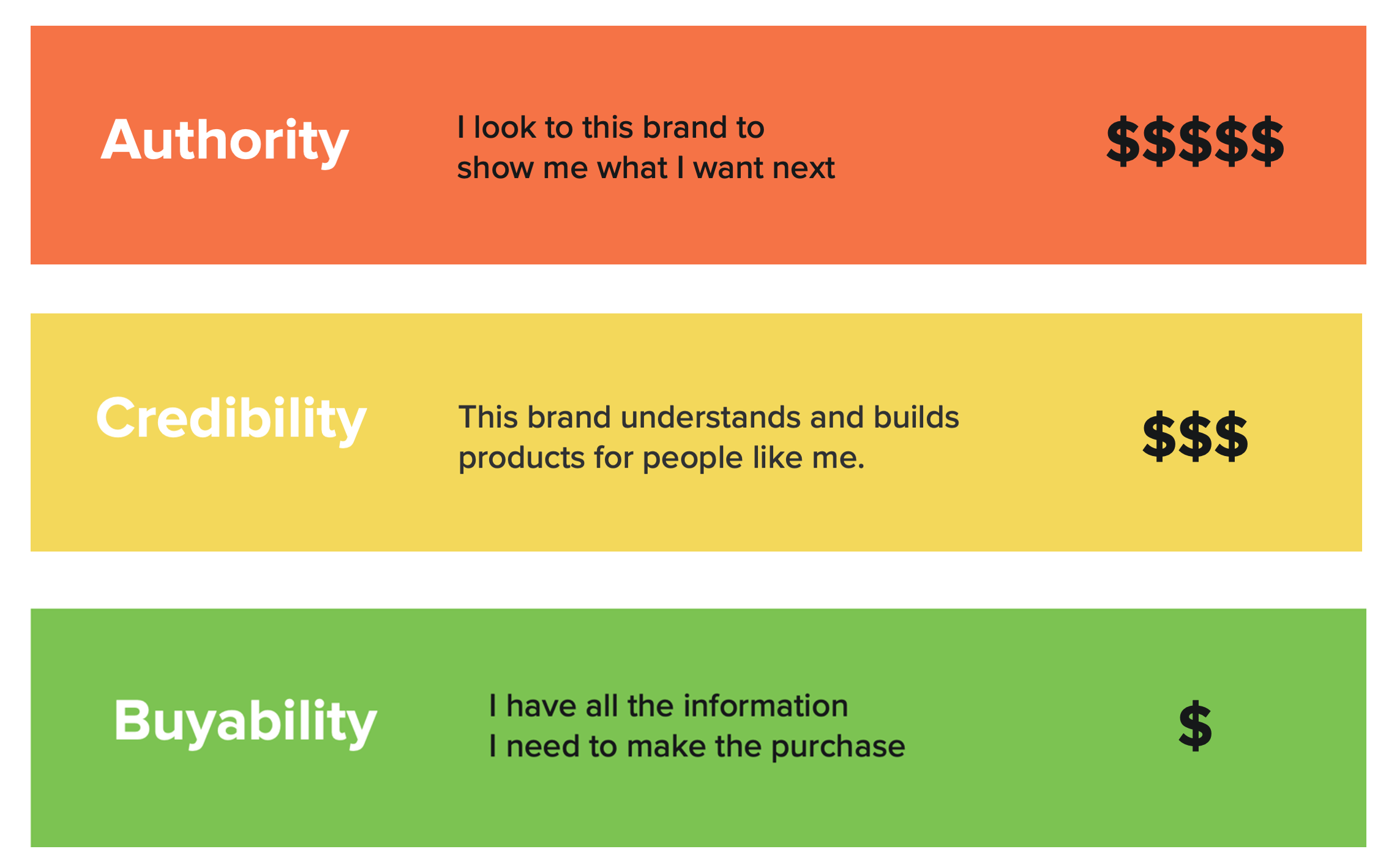
1. Buyability:
The first step in creating a rich product copy is to ensure that you provide your customers with all the relevant information to complete the purchase. Write an accurate, complete, and consistent description that helps users click the “buy now” button.
2. Credibility:
The second step is to build credibility through your product descriptions. Focus on building relationships and let the buyers know that you understand them and build products just for people like them.
3. Authority:
When you build authority, not only do your customers trust you, but they also look up to your brand to show them what they want next. For instance, people didn’t know they wanted a $700 iPhone until Apple came along and created that demand. This is the kind of authority you need if you want to sell top-tier products.
Let’s dig deeper into each layer and understand how to write epic content that sells.
Buyability
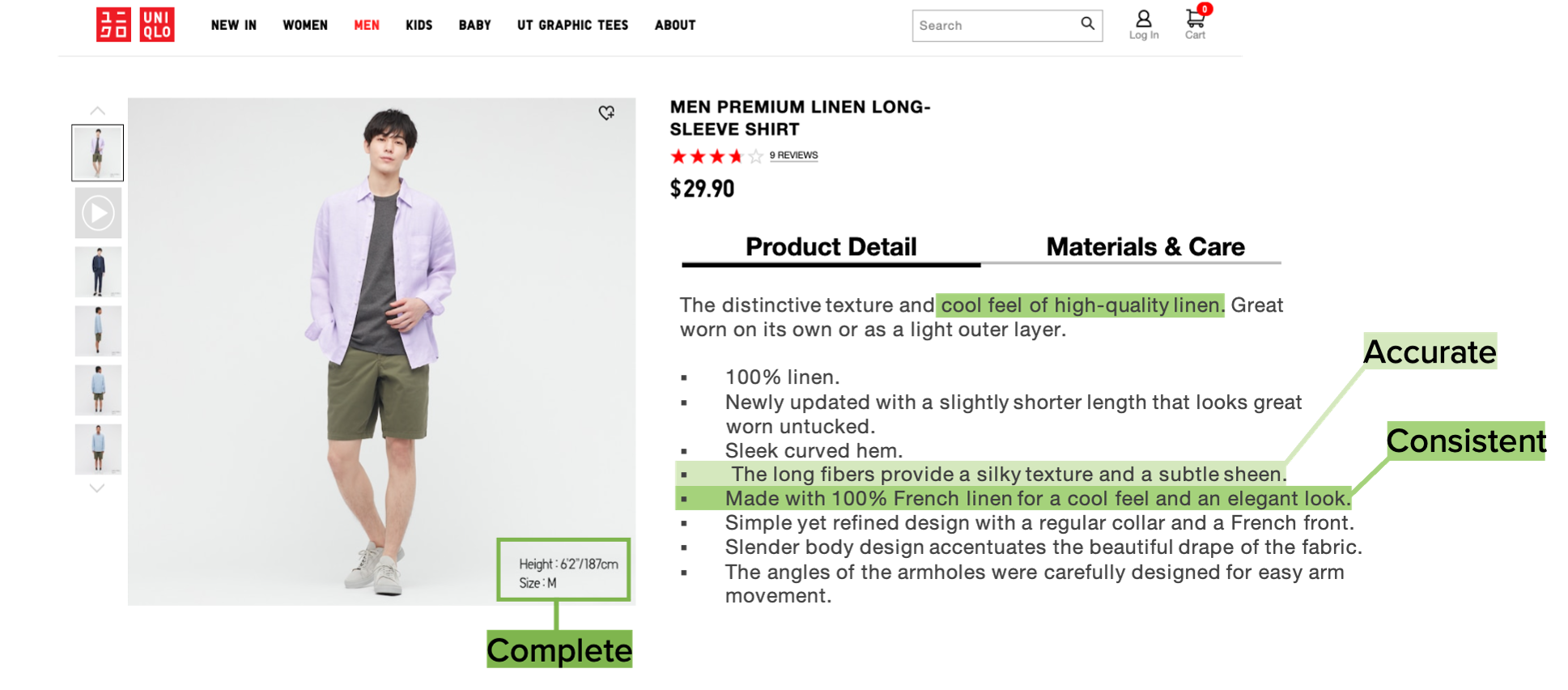
Imagine a heap of returned products lying in your warehouse. Wondering why that might have happened? One major reason can be that your product descriptions did not match the actual product. Customer expectations were not fulfilled.
Flashy words are of no use if they don’t describe your product accurately. Saying a product is of the highest quality when it has numerous complaints, isn’t going to trick people into buying it.
Secondly, consistency plays a huge role in building trust. If you are attributing a benefit to a particular feature, you need to consistently do that across all channels. For example, in this shirt sold by Uniqlo, one benefit of using high-quality cotton is that it gives you a sturdy texture and moderate fitness. Now wherever you use “high-quality cotton”, you should attribute the same benefits to it.
The third element of buyability says that the product description has to be complete. It should have all the information customers need to make the purchase, be it the size, the pricing, the returns policy, or the materials used. Uniqlo has cleverly provided all this information on its product page.
In short, a good product copy should be accurate, consistent, and complete. But this is just the first step. The next layer of the framework tells us the important aspects of building credibility.
Credibility
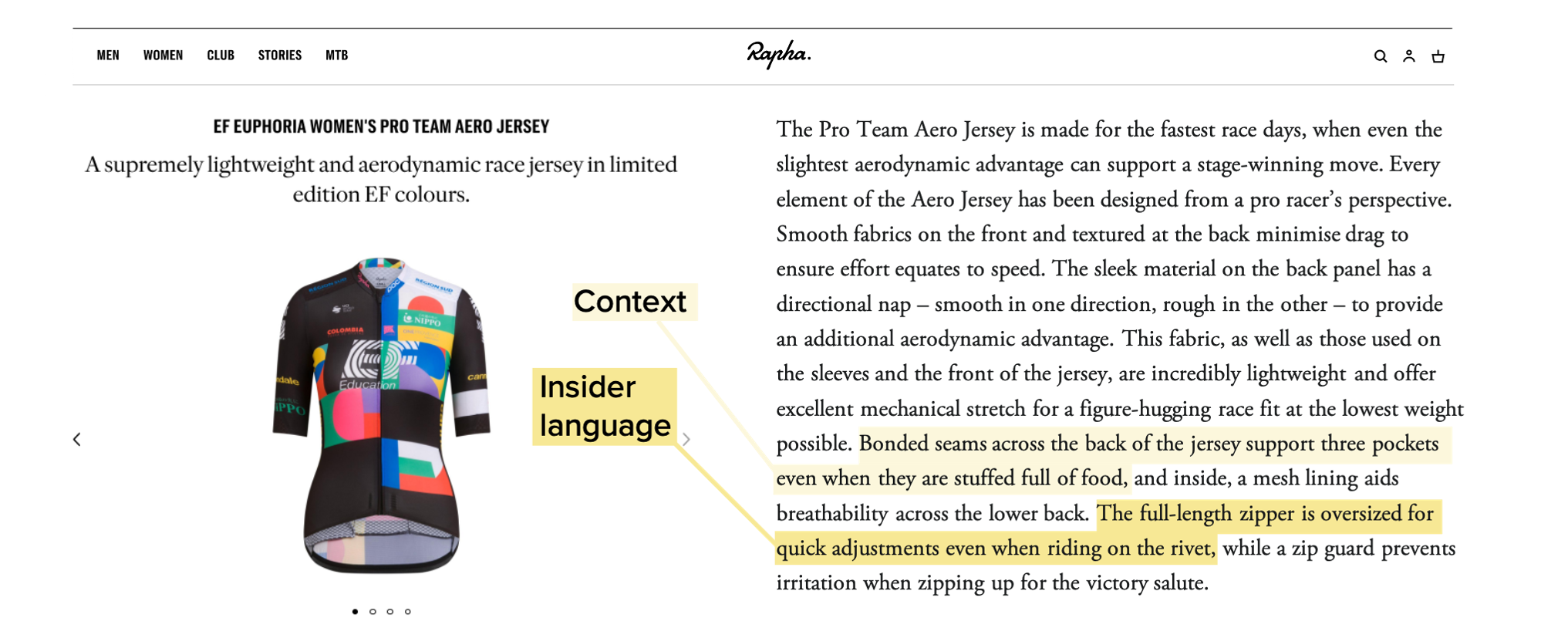
Rapha is a pioneer in cycling equipment. They sell, well… to cyclists. These are the people who love the sport and are willing to pour in money to make their experience better. But, will just facts persuade them? No!
You need to set the context. When you have context around something, you have a larger, more persuasive picture. You tell them how your product fits into their lives perfectly. It helps build more clarity into things that would otherwise seem very boring and dull.
Not just this, notice how Rapha uses insider language in its product descriptions. By doing this, they tell their customers that they know what it’s like to be a cyclist, they know the adrenalin rush, and they understand the pains.
Context and insider language build credibility. They tell the customers how well the company knows its consumers.
Now let’s look at how we can build authority through product descriptions.
Authority
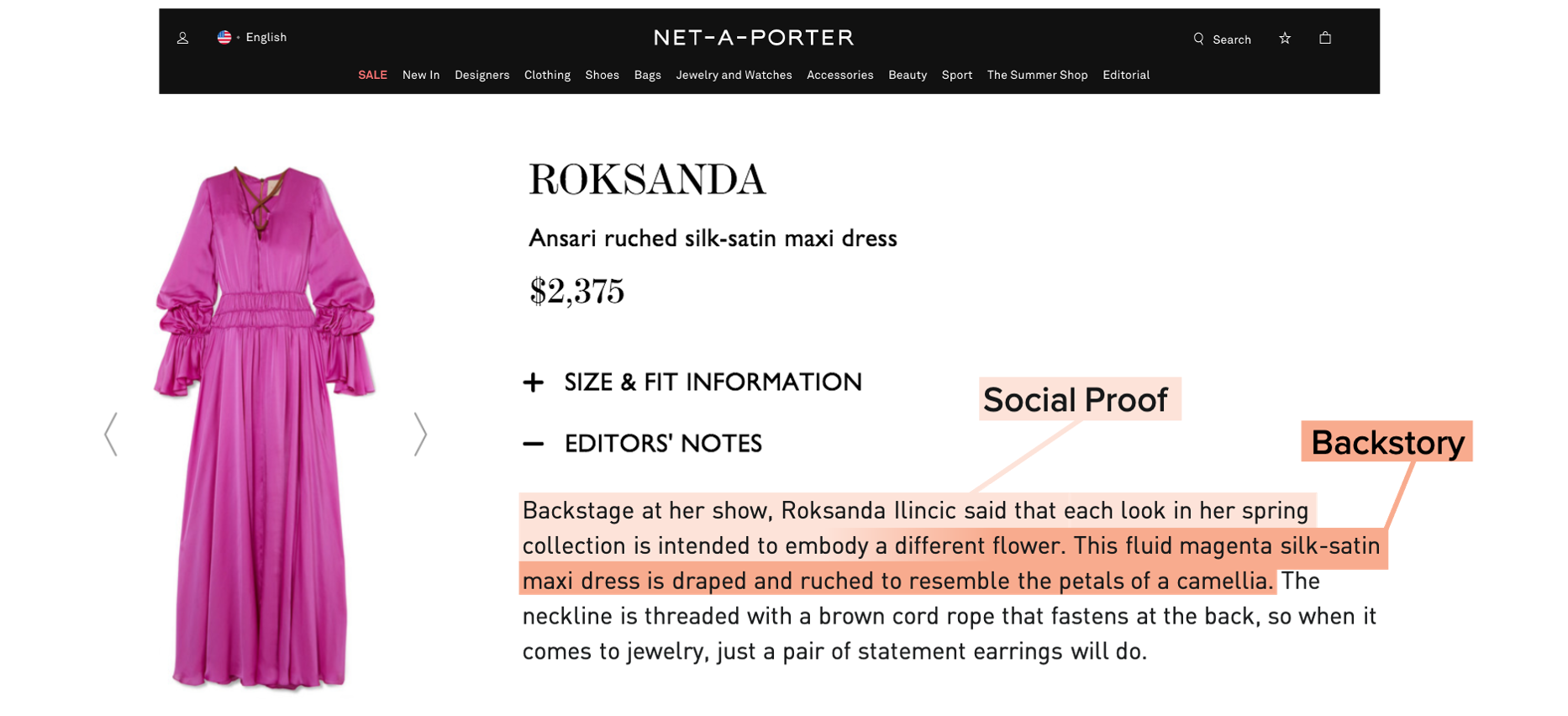
You want to be the brand that your consumers look up to. You want to be the trend-setter.
But how do you build the authority needed to sell trend-leading products? Writing descriptions with mere facts and figures won’t be enough. Stories are how we learn best. We may absorb numbers and facts and details, but stories will help us remember them.
“Great storytelling can make the difference between someone paying attention to you and someone just tuning you out.” —Christopher S. Penn, Digital Marketing Authority
The backstory you choose to tell about your products will persuade customers far more than the features and benefits. What was the backstory? What inspired the production and making of the product?
Net-a-porter, an online fashion retailer, does this job wonderfully. It tells the buyer how the blouse was made, and where it came from. Not just this, the description also includes another most important element of building authority – social proof.
Who designed it? Why did they do it? How did they do it? Who would love it?. All these questions help the buyer feel like the product is made especially for consumers like them. It tells them that the company knows and understands its consumers, which ultimately helps build authority.
Winning product content
Most product descriptions are stuck in the buyability trap. Maybe you don’t have enough time and resources or maybe you don’t know how to stand out. That’s where PIM (product information management) tools like Talkoot can help. It can help enable deeper, more consumer-focused storytelling that helps you become the next Rapha in your space.
